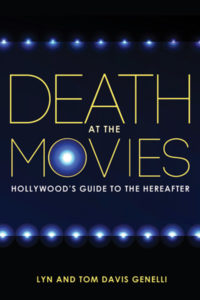What do our stories tell us about who we are? What do our songs, our books, our paintings and our movies reveal about the reality of our existence? Do our artistic expressions point toward deeper truths that lie beyond the merely physical, or is our creative output only a subjective reflection of our innate longings and desires?
In “Death at the Movies: Hollywood’s Guide to the Hereafter” (Quest Books), Lyn and Tom Davis Genelli wrestle with these questions through an exploration of cinema’s metaphysical side, examining what our movies have to say about life, death and beyond.
The Genellis focus on “transit” films: movies that explore a “transition or change, as to a spiritual existence at death.” (3) In their understanding, “the essence of the transit film is to show characters learning and developing, mastering their limitations in an essential way.” (80) These cinematic narratives thereby function as “vehicles for the subconscious infusion of perennial mystical/spiritual concepts about death.” (3)
The authors think that such films reveal important metaphysical truths and set out to show “how popular motion pictures have intuited transit through their visions of death and the afterlife, and how those visions play out their largely unconscious role in the evolution and guidance of human consciousness toward understanding the meaning and purpose of death.” (3)
The Genellis walk us through the metaphysical insights of movies such as It’s a Wonderful Life, Resurrection, Poltergeist, Ghost, Groundhog Day, The Sixth Sense, The Others, Casablanca, The Wizard of Oz and others, exploring the symbols, metaphors, and narrative significance of each in relation to their theme.
They approach their discussion through a broadly Buddhist lens but remain intentionally neutral in regard to specific religious doctrine, choosing to discuss life, love, death, heaven, hell and purgatory in general spiritual terms. This isn’t a book of theological doctrine, but a collection of spiritual reflections on movies.
My only disappoint with the book was the omission of several movies. Ingmar Bergman’s The Seventh Seal and Wild Strawberries surely merit mention in any book about film and death. There’s also fertile ground for discussion in the work of Andrei Tarkovsky — Stalker in particular — as well as Aronofsky’s The Fountain and Kubrick’s 2001: A Space Odyssey. Obviously the authors couldn’t include every film that touches on death — don’t they all? — but for me these were particularly egregious oversights.
“Death at the Movies” offers an important starting point for reflection on how the dominant narrative form of our society both reflects and reinforces our thoughts about the very nature of existence. While I remain dubious of the notion that the films the authors discuss contain actual truths about life after death, I agree that “these two primordial themes — the crisis of death and an intuition of the transcendent” will continue to define and inspire our creative pursuits. A movie may not tell us if we’re going to heaven or hell, but it can give us profound insight into what we think about the afterlife — and about what we value in this life.
 Dan Wilkinson
Dan Wilkinson
Dan is the Executive Editor of the Unfundamentalist blog. He is a writer, graphic designer and IT specialist. He lives in Montana, is married and lives with two cats.

Leave a Reply